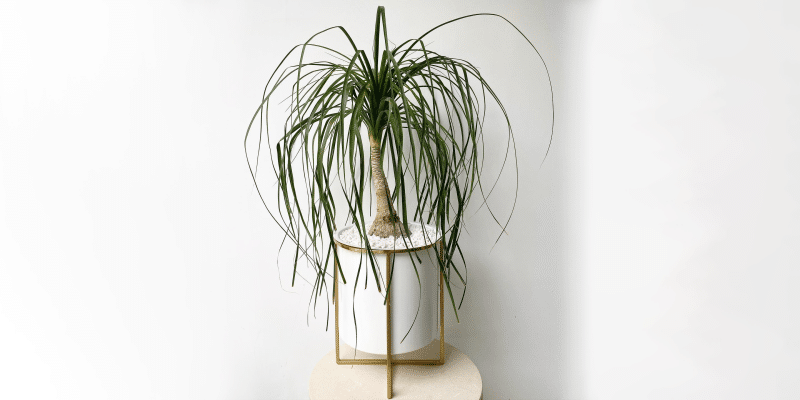Ponytail palm, or elephant-foot tree, falls under the “set it and forget it” category. It can survive for weeks at a time without water, so it’s great for people who travel a lot . . . or forget to water for long stretches (not you, right?).
Thanks, desert climate adaptation!
(It also gives serious desert oasis vibes.)
Let’s learn how to care for a ponytail palm, propagate it, and deal with the most common issues that might come up along the way.
Let’s grow!
Table of Contents
Ponytail Palm Care Guide
History, habitat, and characteristics
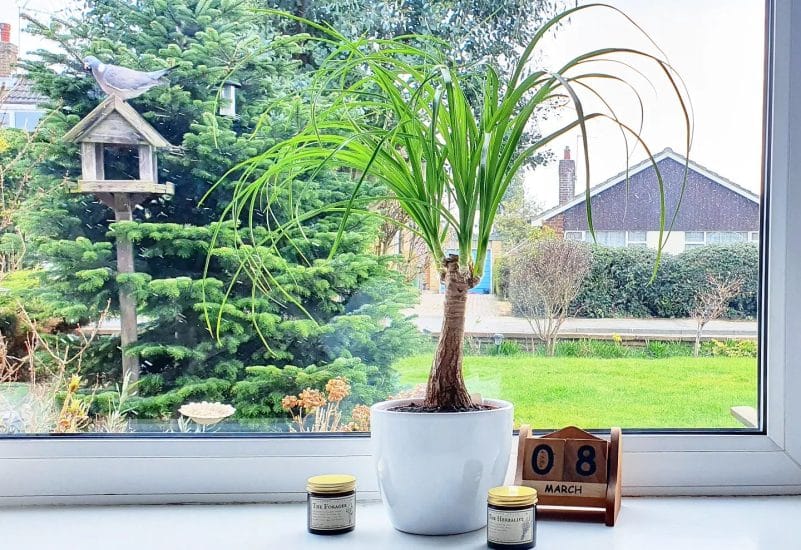
The ponytail palm, or Beaucarnea recurvata, is an evergreen perennial native to the deserts of southeastern Mexico. Recurvata is Latin for “curved backwards,” referring to the rosettes of long, thin leaves that arch from its trunk like a pony’s tail.
This plant’s lush green fronds cascade downward from the top of the trunk, growing up to five feet long.
Speaking of the ponytail palm’s trunk, it’s the reason for the nickname elephant-foot tree (along with ponytail plant, bottle palm, elephant’s foot tree, and elephant’s foot palm).
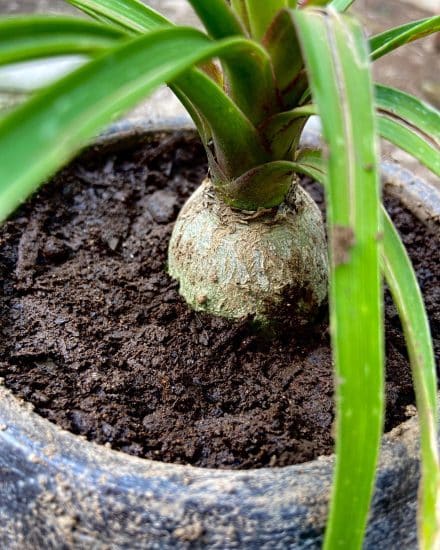
The plant’s base is a gray, bulbous trunk called a caudex that cracks and fissures over time to resemble, you guessed it, an elephant’s foot.
But wait, the caudex has another superpower besides looking like a pachyderm body part — it can grow up to twelve feet in circumference and store large volumes of water. That’s right, this palm is as drought-tolerant as they come.
(This is our favorite soil for the Ponytail Palm.)
Did you know: The ponytail palm is neither a palm nor a tree—while it used to be part of the Ruscaceae family, it’s now classified as a member of the Asparagaceae family, like agave, and considered a succulent. You’ve gotta love botanists and their name changes.
Although these guys grow up to 30 feet tall in the wild, inside, they rarely get higher than 10 feet (kind of like actual elephants). And don’t worry — ponytail palms grow slowly, only about two to four inches a year, so they’ll take a while to get that tall.
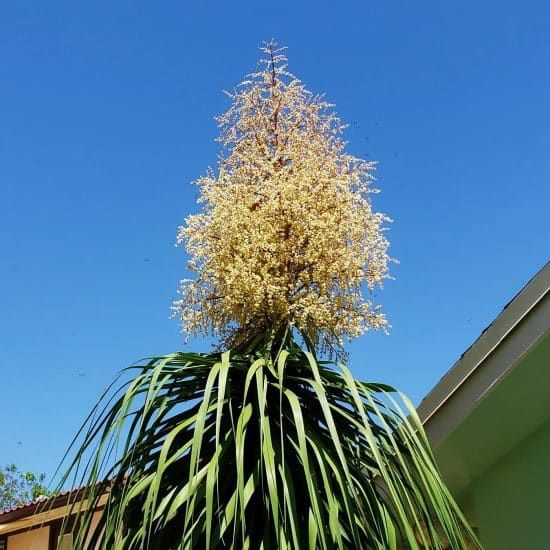
While the ponytail palm does put out showy, creamy white flower clusters called panicles outside, they rarely bloom inside.
Ponytail palm varieties
As if one weren’t enough, there are several varieties of ponytail palms to choose from, including:
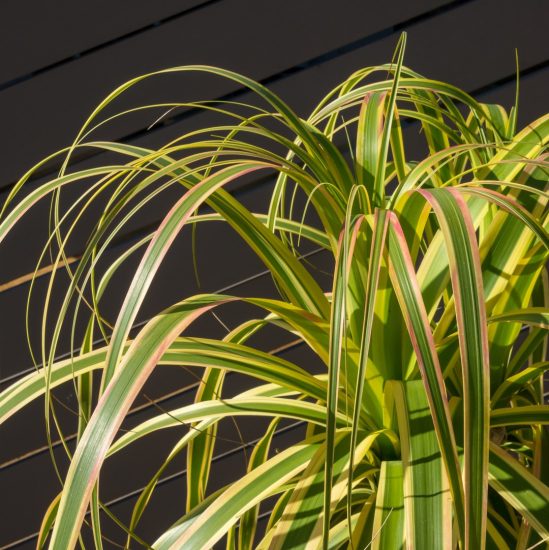
- Beaucarnea recurvata ‘Gold Star’ – Appears similar in shape to the unvariegated version, but has yellow leaf margins with tinges of red
- Beaucarnea compacta – Dwarf species that grows just under 2 feet tall and about 10 inches wide
- Beaucarnea recurvata ‘Variegata’ – Also has a similar shape to the mother plant, but sports dark green leaves with cream-striped margins
- Beaucarnea guatemalensis (Red ponytail plant) – Glossier, longer green leaves that are narrower and more tapered at the tips than the original, twisted slightly, and tinged red
Light
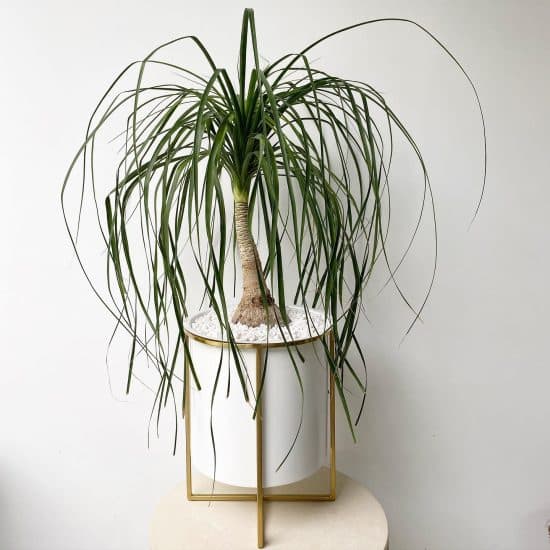
Ponytail palms love full sun, but they can also survive in plenty of bright, indirect light. While they prefer the direct rays streaming through a southern or western exposure, because of their adaptability, they’ll do well in any window of your home.
If your ponytail palm isn’t getting enough light, its leaves may yellow or wilt. If this is the case, consider using a grow light (LED is best to save on energy).
On the other hand, if your ponytail palm gets too much direct sunlight (yes, it is possible!), the leaves may burn, turn brown, and crisp. If its leaves are burning, a sheer curtain on the window can help filter out intense sunlight.
You should also rotate your plant every few weeks to ensure all of its leaves get a chance to bask under the sun and retain even color.
Water
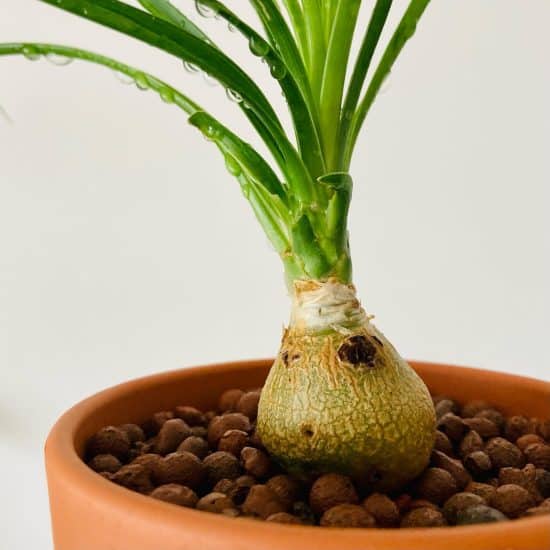
Ponytail palm may be drought-resistant, but it still requires water to grow its . . . ponytail. Because this plant stores water in its trunk, it can go for a few weeks between waterings.
How to tell if it (finally) needs water? You should probe the soil with a finger down to the second knuckle. If this section feels dry, time to break out the watering can. If not, hold off.
Each time you water your ponytail palm, give it a good soak until water is draining out of its container bottom. Then pour out any excess water sitting in the drain tray below.
Ponytail palm watering tips:
- Use lukewarm water to avoid shocking your plant – it doesn’t like cold showers either!
- Tap water will work just fine, but consider using filtered, distilled, or rainwater if you can to avoid salt buildup in the soil.
- If overwatered, the soil will be too soggy, causing leaves (new and old) to yellow and wilt, and roots to rot.
- If underwatered, the soil will be dry, stunting growth and causing leaves to turn yellow from lack of nutrients.
- Water less in the winter when your plant is dormant, about once a month.
Temperature and humidity
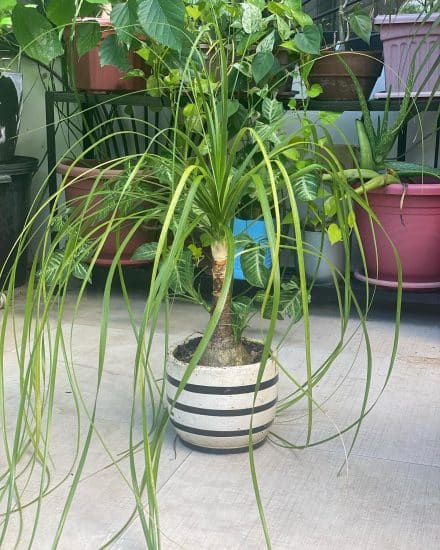
Ponytail palm thrives in a warm and dry environment like the arid desert climate of its native habitat. It does well in normal household temperatures of 60-85 degrees Fahrenheit (okay, maybe a little higher than some of us are comfortable with).
Keep your plant away from drafty doors and windows, and make sure its environment doesn’t go below 50 degrees F indoors — warm and cozy is the key here.
Its desert origins means ponytail palm is also fine with regular household humidity in the range of 25-40%, or even drier air.
Tip: Don’t mist your plant’s leaves, since this, A, isn’t necessary, and B, makes them prone to rot. You can, however, wipe its leaves with a damp cloth to remove dust and potential pests.
Soil and planting
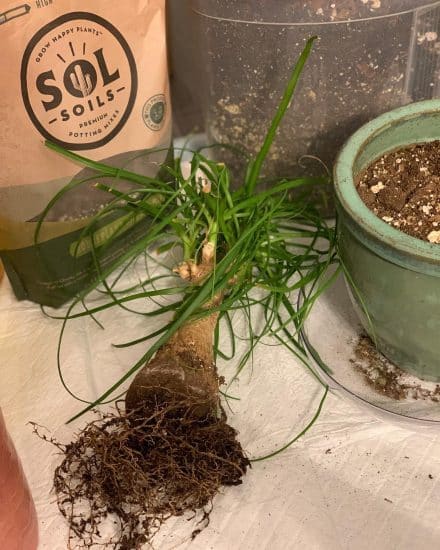
Just like other succulents, the ponytail palm needs a fast-draining, loose potting soil that lets plenty of oxygen reach its roots. You can pick up premade cactus or succulent potting mix for your indoor ponytail palm, or create your own using:
- 40% gardening soil (adds essential nutrients)
- 40% sand (helps with drainage)
- 20% pumice or perlite (helps soil stay loose and aerated)
Pruning
Ponytail palm doesn’t need much pruning other than occasionally clipping off brown or scraggly leaves.
Did you know: You can encourage your palm to grow multiple branches by breaking off or cutting the plant when it’s still small (less than 6 inches around). New stems will grow from each cut.
Repotting
Ponytail palm is a slow grower, so it will only need to be repotted at most once every other year. Use a small pot that’s only two inches bigger than your plant’s caudex, or woody base, and make sure it has at least one drainage hole.
Your palm will appreciate a clay pot, since it helps wick away moisture faster than a plastic one, and these guys don’t like to sit in wet soil for long.
Fertilizing
It’s important to fertilize your ponytail palm during the spring and summer. While you can use a diluted balanced houseplant fertilizer with no issues, I recommend . . . a slow-release cacti/succulent fertilizer with a macronutrient ratio of 3:1:3 (3 parts nitrogen, 1 part phosphorus, and 3 parts potassium).
The best part? Because it releases fertilizer slowly over time, you don’t have to fertilize again for three months.
On to ponytail palm propagation (I like alliteration . . . and rhymes)!
Propagation guide
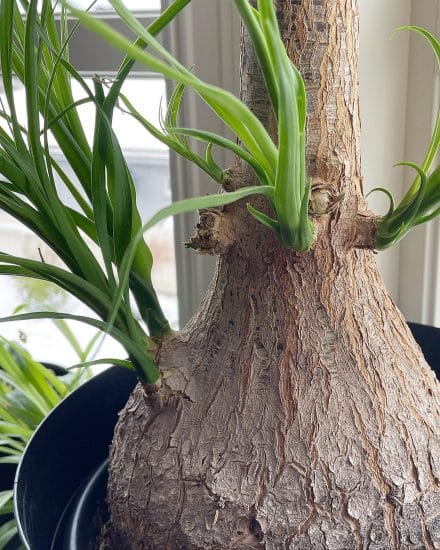
The easiest way to propagate your ponytail palm is by using pups (also called offsets or offshoots) that form around the base of the mother plant as it grows. The best time to do this is in spring.
Propagating ponytail palm by pup division:
- Cut off a healthy pup that’s at least four inches long with a sharp, sterilized blade. You should see a healthy root structure attached: be sure to include it! Let it dry out for a day so the cut wound can heal (this helps prevent stem rot).
- Dip the cut end of the pup in powdered rooting hormone.
- Plant the pup about 1/3 of the way down into cacti/succulent mix, supporting it with rocks if it’s too weak to stand on its own.
- Keep it in an area with bright indirect light (offshoots won’t be able to take direct sunlight until they’ve grown a bit more). Make sure to keep the soil moist but not drenched.
- After a few weeks when it’s more well-established, you’ll be able to treat your new ponytail palm just like the mother plant (aka, direct light and normal watering schedule).
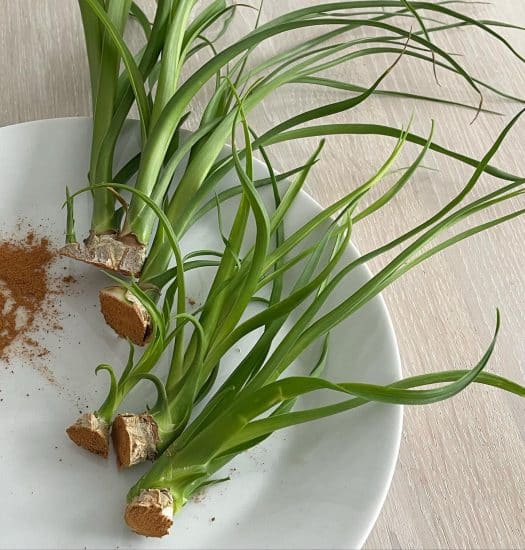
Next, we’ll find out how to deal with any common issues your ponytail palm might have, like brown leaves or bugs.
Common issues
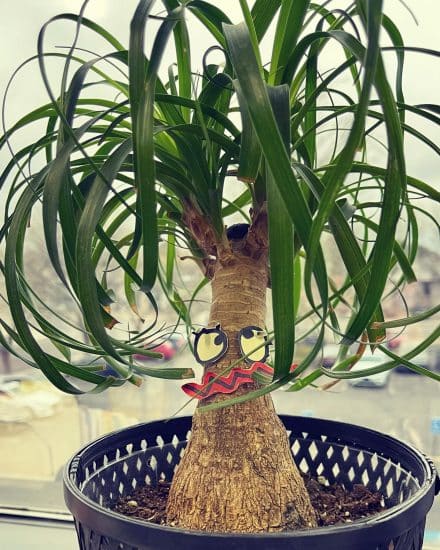
Ponytail palms are about as low maintenance as they come, but I’ll tell you how to avoid yellow leaves and vanquish potential pests.
Brown Tips: If your plant’s leaf tips are light brown, it might be thirsty. Make sure you give your ponytail palm a good watering, and it should recover soon enough. However, if the tips of the leaves are turning black, this could be an indication of overwatering. Check the soil and make sure it’s not soggy. If it is, hold off on the hydration for a while.
If your plant is getting too much direct, sun exposure, it might also develop brown tips or patches. If your watering habits are on par, move your palm back from the window a few feet to reduce the light intensity.
Yellowing Leaves: Ponytail palm leaf tips will turn yellow and leaves will droop if they’re being overwatered. Wait until soil dries out at least two inches down before watering again.
If you’re seeing yellow, sagging fronds and you haven’t watered in a long time (think weeks), this is a good indicator that your plant needs a drink.
Diseases and pests
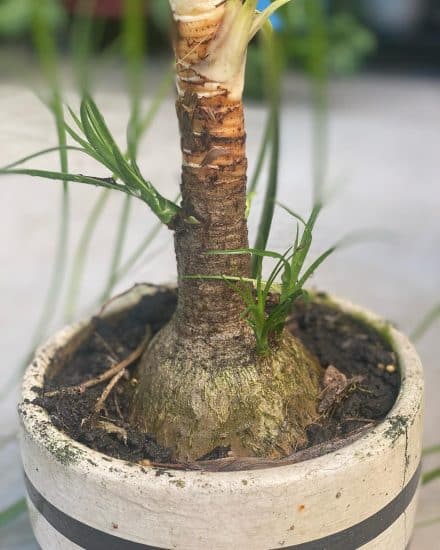
Suspect your plant has root rot, fungus, or bugs? Here’s how to act fast and nip them in the bud.
Root Rot
Seeing yellowing and wilting leaves, brown spots, and mushy black roots on older plants? Remember: this plant is a succulent and prone to rot if it sits in soggy soil.
Solution: To prevent root rot, check the soil and make sure it’s not waterlogged. If it is, let it dry out thoroughly before watering it again. If roots are already black and slimy, cut off the affected portions and repot your plant with fresh soil, letting it completely dry out between waterings.
Fungus
Fungal diseases on ponytail palms can look like yellow halos or lesions, or a white powdery substance on the leaves combined with wilting.
Solution: To prevent fungus, be careful not to overwater your palm and avoid splashing the foliage. If you notice any fungus appearing, act quickly with a fungicide to help prevent the problem from spreading.
Pests
Mealybugs (small white cottony masses) and spider mites (tiny white or yellow spots; webbing on stems and leaf undersides) can occasionally be a problem for ponytail palms.
Solution: Isolate your plant from others so the pests don’t spread. Wipe down leaves with a damp cloth and soapy water. For persistent or more serious infestations, use a natural insecticide like diluted neem oil.
Conclusion
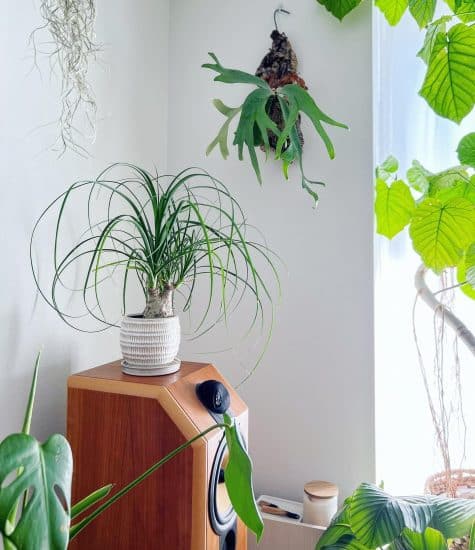
Ponytail palm is a forgiving plant that can thrive in a variety of temperatures and even withstand some missed waterings (way to redefine low maintenance!).
A classic houseplant that brightens up any room and doesn’t require much care? Sign me up!
If you found this article useful, send it to a new ponytail palm parent. Questions? Ask us on Facebook or Instagram — we love helping fellow plant lovers!
FAQ
Does a ponytail palm need sun or shade?
These guys love bright light, so the more sun, the better. While they can grow in indirect sunlight, they don’t like shade.
How do you take care of a potted ponytail palm?
You don’t. Just kidding! Water it when the soil is dry a few inches down and make sure it gets lots of sunlight.
Is ponytail palm low maintenance?
It doesn’t get much easier than a ponytail palm. They store water in their trunks for weeks at a time — perfect for frequent travelers or slightly neglectful plant parents.
How long does a ponytail palm last?
These plants can live over 100 years!
Should I mist my ponytail palm?
Nope, it’s not necessary, since they thrive in dry air (aka low humidity). Misting them would only encourage leaf rot.

